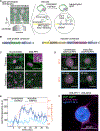Quantitative imaging of RNA polymerase II activity in plants reveals the single-cell basis of tissue-wide transcriptional dynamics
- PMID: 34373604
- PMCID: PMC8616715
- DOI: 10.1038/s41477-021-00976-0
Quantitative imaging of RNA polymerase II activity in plants reveals the single-cell basis of tissue-wide transcriptional dynamics
Abstract
The responses of plants to their environment are often dependent on the spatiotemporal dynamics of transcriptional regulation. While live-imaging tools have been used extensively to quantitatively capture rapid transcriptional dynamics in living animal cells, the lack of implementation of these technologies in plants has limited concomitant quantitative studies in this kingdom. Here, we applied the PP7 and MS2 RNA-labelling technologies for the quantitative imaging of RNA polymerase II activity dynamics in single cells of living plants as they respond to experimental treatments. Using this technology, we counted nascent RNA transcripts in real time in Nicotiana benthamiana (tobacco) and Arabidopsis thaliana. Examination of heat shock reporters revealed that plant tissues respond to external signals by modulating the proportion of cells that switch from an undetectable basal state to a high-transcription state, instead of modulating the rate of transcription across all cells in a graded fashion. This switch-like behaviour, combined with cell-to-cell variability in transcription rate, results in mRNA production variability spanning three orders of magnitude. We determined that cellular heterogeneity stems mainly from stochasticity intrinsic to individual alleles instead of variability in cellular composition. Together, our results demonstrate that it is now possible to quantitatively study the dynamics of transcriptional programs in single cells of living plants.
© 2021. The Author(s), under exclusive licence to Springer Nature Limited.
Figures





Comment in
-
Noisy transcription under the spotlight.Nat Plants. 2021 Aug;7(8):996-997. doi: 10.1038/s41477-021-00987-x. Nat Plants. 2021. PMID: 34373606 No abstract available.
Similar articles
-
Live single-cell transcriptional dynamics via RNA labelling during the phosphate response in plants.Nat Plants. 2021 Aug;7(8):1050-1064. doi: 10.1038/s41477-021-00981-3. Epub 2021 Aug 9. Nat Plants. 2021. PMID: 34373603
-
Immediate transcriptional responses of Arabidopsis leaves to heat shock.J Integr Plant Biol. 2021 Mar;63(3):468-483. doi: 10.1111/jipb.12990. Epub 2020 Jul 28. J Integr Plant Biol. 2021. PMID: 32644278
-
An Engineered Heat-Inducible Expression System for the Production of Casbene in Nicotiana benthamiana.Int J Mol Sci. 2023 Jul 13;24(14):11425. doi: 10.3390/ijms241411425. Int J Mol Sci. 2023. PMID: 37511181 Free PMC article.
-
HSFA2 orchestrates transcriptional dynamics after heat stress in Arabidopsis thaliana.Transcription. 2016 Aug 7;7(4):111-4. doi: 10.1080/21541264.2016.1187550. Epub 2016 Jul 6. Transcription. 2016. PMID: 27383578 Free PMC article. Review.
-
The heat shock response: A case study of chromatin dynamics in gene regulation.Biochem Cell Biol. 2013 Feb;91(1):42-8. doi: 10.1139/bcb-2012-0075. Epub 2013 Feb 13. Biochem Cell Biol. 2013. PMID: 23442140 Review.
Cited by
-
Single seeds exhibit transcriptional heterogeneity during secondary dormancy induction.Plant Physiol. 2022 Aug 29;190(1):211-225. doi: 10.1093/plphys/kiac265. Plant Physiol. 2022. PMID: 35670742 Free PMC article.
-
Digital paradigm for Polycomb epigenetic switching and memory.Curr Opin Plant Biol. 2021 Jun;61:102012. doi: 10.1016/j.pbi.2021.102012. Epub 2021 Mar 1. Curr Opin Plant Biol. 2021. PMID: 33662809 Free PMC article. Review.
-
Research progress of live-cell RNA imaging techniques.Zhejiang Da Xue Xue Bao Yi Xue Ban. 2022 Jun 25;51(3):362-372. doi: 10.3724/zdxbyxb-2022-0017. Zhejiang Da Xue Xue Bao Yi Xue Ban. 2022. PMID: 36207827 Free PMC article. Review. English.
-
Bet-hedging and variability in plant development: seed germination and beyond.Philos Trans R Soc Lond B Biol Sci. 2024 Apr 22;379(1900):20230048. doi: 10.1098/rstb.2023.0048. Epub 2024 Mar 4. Philos Trans R Soc Lond B Biol Sci. 2024. PMID: 38432313 Free PMC article. Review.
-
Biological and Molecular Components for Genetically Engineering Biosensors in Plants.Biodes Res. 2022 Nov 9;2022:9863496. doi: 10.34133/2022/9863496. eCollection 2022. Biodes Res. 2022. PMID: 37850147 Free PMC article.
References
-
- Angel A, Song J, Dean C, and Howard M. (2011). A Polycomb-based switch underlying quantitative epigenetic memory. Nature, 476(7358):105–109. - PubMed
-
- Ardehali MB and Lis JT (2009). Tracking rates of transcription and splicing in vivo. Nature Structural and Molecular Biology, 16(11):1123–1124. - PubMed
-
- Arganda-Carreras I, Kaynig V, Rueden C, Eliceiri KW, Schindelin J, Cardona A, and Seung HS (2017). Trainable Weka Segmentation: A machine learning tool for microscopy pixel classification. Bioinformatics, 33(15):2424–2426. - PubMed
MeSH terms
Substances
Grants and funding
LinkOut - more resources
Full Text Sources
Other Literature Sources
Research Materials

